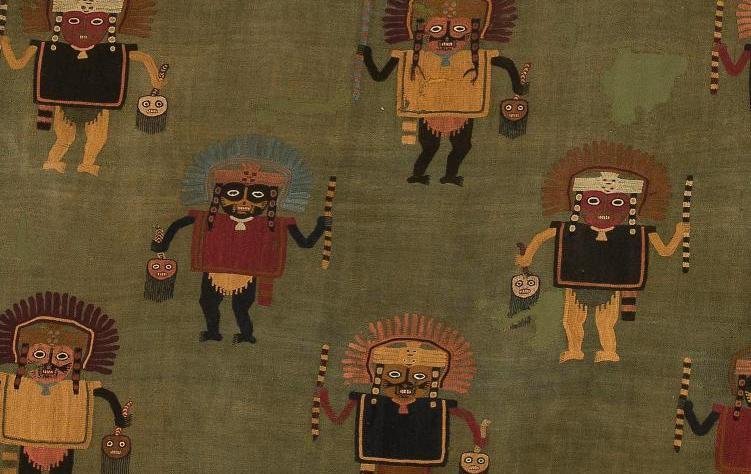Review: Peru, A Journey in Time
Textile fragment with embroidered hummingbirds, early Nasca, 100 BC - AD 200, British Museum, London (Image: British Museum)
The British Museum’s newest exhibition ‘Peru: A Journey In Time’ – organised in collaboration with Museo de Arte de Lima – charts the cultures and histories of indigenous communities based in the Central Andes, from the first settlements over 5000 years ago to the arrival of colonists in 1532. It presents an astonishing variety of ceramics, textiles and objects from numerous Andean tribes, including Inca, Nasca, Moche and Chimu communities. The exhibition not only invites visitors to learn about the specific customs, rituals and lifestyles of each community and its history, it also emphasises that indigenous knowledge is rooted in an interconnectedness with the natural world and landscapes. One panel in the exhibition reads: ‘For Andean people, nature itself is a living being… sustaining all life.’ The persistence of this outlook (and practices) in modern indigenous communities is shown through short film interviews dotted throughout the exhibition, including a fisherman, a farmer and a weaver.
A highlight of the exhibition is the range of Moche ceramic vessels… from naturalistic human portraits of high status citizens, animal/human creatures, to ordinary people like a fisherman in his reed boat. Textiles also feature heavily: a vast Nasca funerary blanket made between 100 BC – AD 100 merits close and considered attention. Made up of 74 images, it depicts human figures wearing diadems and holding severed heads, each with a remarkable variation on colour and details. In one of the final display cases, an artwork produced by weavers in the community of Pitumarca, Cusco, visually incorporates over 1,000 years of tradition. It contains four sections (Wari, Inca, colonial and Republican) with a stepped cross motif at its centre (dating back to pre-colonial times). The artwork leaves visitors with an understanding of just how alive and thriving indigenous Andean communities are today, despite centuries of colonial suppression.
Detail from painted pottery human figurine vessel, Moche, AD 100-800, British Museum, London (Image: British Museum)
Painted pottery vessel depicting a fisherman in a reed boat, Moche, AD 100–800, Staatliche Museen zu Berlin, Ethnologisches Museum (Image: The British Museum Blog)
In many ways, the exhibition is an exciting celebration of indigenous Andean communities, particularly since it has been curated in collaboration with Peru’s national art museum. Visitors, particularly those who have never been to an exhibition devoted to Andean archaeological artefacts, are certainly spoiled by the craftsmanship and quality of the objects on display. The careful distinctions made between each community, area and time period – through thoughtfully arranged display cases and labels – encourage a clear appreciation of the variety (and innumerable differences) of these histories.
But there is also a darker side to the story, related to the British Museum’s funding. By devoting an entire exhibition to indigenous Andean histories, the museum clearly wants to establish itself as a socially progressive institution which is seeking new post-colonial narratives and ‘striving to lessen its environmental impact’ (as written on the exhibition’s final panel). This is undermined by the close links the museum retains to the oil giant BP, which has been criticised destroying the lands, cultures and lives of indigenous communities across the world. Earlier this month on 11 November, more than 120 museum, heritage and archaeology professionals signed an open letter calling on the British Museum to cut ties with BP, explaining that ‘BP is taking advantage of [the museum’s] status as a highly respected institution, and of the public’s love of museums and heritage, to associate its brand with values of high culture, art, education, sophistication, reason, and knowledge.’
Detail from mantle depicting human figures with feline mouth masks holding severed heads, early Nasca, 100 BC-AD 100, Museo de Arte de Lima, Peru (Image: Museo de Arte de Lima)
Hundreds of indigenous people came from across the world to COP26 in Glasgow, which ended earlier this week; many were excluded from talks, and environmental activists have unanimously deemed the conference a ‘failure’. Before travelling to Glasgow, indigenous activists from across the Americas (in the coalition Minga Indígena) even paid a visit to the British Museum, where they held an unauthorised healing ceremony in recognition of colonial and climate injustices. Whilst the British Museum’s latest exhibition teaches visitors about the value of indigenous approaches to the natural world – and will hopefully help visitors to question our own society’s detachment with nature – the museum’s actions outside of this exhibition only demonstrate the contradictions embedded in many cultural institutions. The Peru exhibition closes with the powerful statement: ‘Past traditions inform present practice, and the enduring belief that humans are a part of the living landscape helps to shape our shared future. The objects in this exhibition connect this narrative’. As long as the British Museum continues to support extraction of fossil fuels (and all of the social, ecological and cultural destruction that comes with it), these words ring hollow.
Peru: A Journey In Time will be running until 20 February 2022.
(Written by Esme Garlake on behalf of Athena Art Foundation, November 2021)



